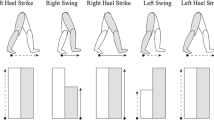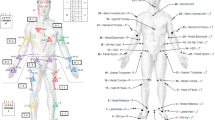Abstract
Our prior work provides evidence that visual feedback distortion drives an implicit adaptation; a gradual distortion of visual representation of step length modulated subjects’ step lengths away from symmetry. To further explore the effect of the visual feedback distortion on unconscious change in step symmetry, we investigated whether such adaptation would occur even in the presence of altered limb mechanics by adding mass to one side of the leg. 26 subjects performed three 8–min trials (weight only, weight plus visual feedback, and weight plus visual feedback distortion) of treadmill walking. During the weight only trial, the subjects wore a 5 lb mass around the right ankle. The modification of limb inertia caused asymmetric gait. The visual feedback showing right and left step length information as bar graphs was displayed on a computer screen. To add visual feedback distortion, we increased the length of one side of the visual bars by 10% above the actual step length, and the visual distortion was implemented for the side that took longer in response to the added mass. We found that even when adjustments were made to unilateral loading, the subjects spontaneously changed their step symmetry in response to the visual distortion, which resulted in a more symmetric gait. This change may be characterized by sensory prediction errors, and our results suggest that visual feedback distortion has a significant impact on gait symmetry regardless of other conditions affecting limb mechanics. A rehabilitation program employing visual feedback distortion may provide an effective way to restore gait symmetry.






Similar content being viewed by others
References
Balasubramanian, C. K., M. G. Bowden, R. R. Neptune, and S. A. Kautz. Relationship between step length asymmetry and walking performance in subjects with chronic hemiparesis. Arch. Phys. Med. Rehabil. 88:43–49, 2007.
Butt, S. J. B., J. M. Lebret, and O. Kiehn. Organization of left-right coordination in the mammalian locomotor network. Brain Res. Brain Res. Rev. 40:107–117, 2002.
Cho, K. H., and W. H. Lee. Virtual walking training program using a real-world video recording for patients with chronic stroke: A pilot study. Am. J. Phys. Med. Rehabil. 92:371–384, 2013.
Hb, S., and B. Rl. Ankle weighting effect on gait in able-bodied adults. Arch. Phys. Med. Rehabil. 71:112–115, 1990.
Higginson, J. S., F. E. Zajac, R. R. Neptune, S. A. Kautz, and S. L. Delp. Muscle contributions to support during gait in an individual with post-stroke hemiparesis. J. Biomech. 39:1769–1777, 2006.
Hodt-Billington, C., J. L. Helbostad, and R. Moe-Nilssen. Should trunk movement or footfall parameters quantify gait asymmetry in chronic stroke patients? Gait Posture 27:552–558, 2008.
Hornby, T. G., D. D. Campbell, J. H. Kahn, T. Demott, J. L. Moore, and H. R. Roth. Enhanced gait-related improvements after therapist- versus robotic-assisted locomotor training in subjects with chronic stroke. Stroke 39:1786–1792, 2008.
Ivanenko, Y. P., R. E. Poppele, and F. Lacquaniti. Distributed neural networks for controlling human locomotion: Lessons from normal and SCI subjects. Brain Res. Bull. 78:13–21, 2009.
Kamruzzaman, J., and R. K. Begg. Support vector machines and other pattern recognition approaches to the diagnosis of cerebral palsy gait. IEEE Trans. Biomed. Eng. 53:2479–2490, 2006.
Kawato, M. Internal models for motor control and trajectory planning. Curr. Opin. Neurobiol. 9:718–727, 1999.
Kim, S.-J., M. A. Kayitesi, A. Chan, and K. Graham. Effects of partial absence of visual feedback information on gait symmetry. Appl. Psychophysiol. Biofeedback 42:1–9, 2017. doi:10.1007/s10484-017-9358-0.
Kim, S.-J., and H. I. Krebs. Effects of implicit visual feedback distortion on human gait. Exp. Brain Res. 218:495–502, 2012.
Kim, S.-J., and D. Mugisha. Effect of explicit visual feedback distortion on human gait. J. Neuroeng. Rehabil. 11:74, 2014.
Kim, S. J., M. Ogilvie, N. Shimabukuro, T. Stewart, and J. H. Shin. Effects of visual feedback distortion on gait adaptation: Comparison of implicit visual distortion versus conscious modulation on retention of motor learning. IEEE Trans. Biomed. Eng. 62:2244–2250, 2015.
Kim, S. J., M. Ogilvie, N. Shimabukuro, T. Stewart, and J. H. Shin. Effects of visual feedback distortion on gait adaptation: Comparison of implicit visual distortion versus conscious modulation on retention of motor learning. IEEE Trans. Biomed. Eng. 62:2244–2250, 2015.
Kodesh, E., M. Kafri, G. Dar, and R. Dickstein. Walking speed, unilateral leg loading, and step symmetry in young adults. Gait Posture 35:66–69, 2012.
Kornheiser, A. S. Adaptation to laterally displaced vision: A review. Psychol. Bull. 83:783–816, 1976.
Krakauer, J. W. Motor learning and consolidation: The case of visuomotor rotation. Adv. Exp. Med. Biol. 629:405–421, 2009.
Krebs, H. I., B. T. Volpe, M. L. Aisen, and N. Hogan. Increasing productivity and quality of care: Robot-aided neuro-rehabilitation. J. Rehabil. Res. Dev. 37:639, 2000.
Kubo, K., T. Miyoshi, A. Kanai, and K. Terashima. Gait rehabilitation device in central nervous system disease: A review. J. Robot. 2011:e348207, 2011.
Laufer, Y., R. Dickstein, Y. Chefez, and E. Marcovitz. The effect of treadmill training on the ambulation of stroke survivors in the early stages of rehabilitation: A randomized study. J. Rehabil. Res. Dev. 38:69–78, 2001.
Levin, I., M. D. Lewek, J. Feasel, and D. E. Thorpe. Gait training with visual feedback and proprioceptive input to reduce gait asymmetry in adults with cerebral palsy: A case series. Pediatr. Phys. Ther. 29:138–145, 2017.
Lewek, M. D., J. Feasel, E. Wentz, F. P. Brooks, and M. C. Whitton. Use of visual and proprioceptive feedback to improve gait speed and spatiotemporal symmetry following chronic stroke: A case series. Phys. Ther. 92:748–756, 2012.
Malone, L. A., and A. J. Bastian. Thinking about walking: effects of conscious correction versus distraction on locomotor adaptation. J. Neurophysiol. 103:1954–1962, 2010.
Mazzoni, P., and J. W. Krakauer. An implicit plan overrides an explicit strategy during visuomotor adaptation. J. Neurosci. Off. J. Soc. Neurosci. 26:3642–3645, 2006.
Noble, J. W., and S. D. Prentice. Adaptation to unilateral change in lower limb mechanical properties during human walking. Exp. Brain Res. 169:482–495, 2006.
Patterson, K. K., N. K. Nadkarni, S. E. Black, and W. E. McIlroy. Gait symmetry and velocity differ in their relationship to age. Gait Posture 35:590–594, 2012.
Patterson, K. K., I. Parafianowicz, C. J. Danells, V. Closson, M. C. Verrier, W. R. Staines, S. E. Black, and W. E. McIlroy. Gait asymmetry in community-ambulating stroke survivors. Arch. Phys. Med. Rehabil. 89:304–310, 2008.
Plummer, P., A. L. Behrman, P. W. Duncan, P. Spigel, D. Saracino, J. Martin, E. Fox, M. Thigpen, and S. A. Kautz. Effects of stroke severity and training duration on locomotor recovery after stroke: A pilot study. Neurorehabilit. Neural Repair 21:137–151, 2007.
Protas, E. J., S. A. Holmes, H. Qureshy, A. Johnson, D. Lee, and A. M. Sherwood. Supported treadmill ambulation training after spinal cord injury: A pilot study. Arch. Phys. Med. Rehabil. 82:825–831, 2001.
Redding, G. M., and B. Wallace. Adaptive spatial alignment and strategic perceptual-motor control. J. Exp. Psychol. Hum. Percept. Perform. 22:379–394, 1996.
Redding, G. M., and B. Wallace. Generalization of prism adaptation. J. Exp. Psychol. Hum. Percept. Perform. 32:1006–1022, 2006.
Rosati, G., A. Rodà, F. Avanzini, and S. Masiero. On the role of auditory feedback in robot-assisted movement training after stroke: Review of the literature. Intell. Neurosci. 2013(11):11, 2013.
Sadeghi, H., P. Allard, F. Prince, and H. Labelle. Symmetry and limb dominance in able-bodied gait: A review. Gait Posture 12:34–45, 2000.
Schaefer, S. Y., I. L. Shelly, and K. A. Thoroughman. Beside the point: Motor adaptation without feedback-based error correction in task-irrelevant conditions. J. Neurophysiol. 107:1247–1256, 2012.
Smith, J. D., and P. E. Martin. Walking patterns change rapidly following asymmetrical lower extremity loading. Hum. Mov. Sci. 26:412–425, 2007.
Stolze, H., S. Klebe, C. Baecker, C. Zechlin, L. Friege, S. Pohle, and G. Deuschl. Prevalence of gait disorders in hospitalized neurological patients. Mov. Disord. 20:89–94, 2005.
Thibaut, A., C. Chatelle, E. Ziegler, M.-A. Bruno, S. Laureys, and O. Gosseries. Spasticity after stroke: Physiology, assessment and treatment. Brain Inj. 27:1093–1105, 2013.
Thikey, H., M. Grealy, F. van Wijck, M. Barber, and P. Rowe. Augmented visual feedback of movement performance to enhance walking recovery after stroke: Study protocol for a pilot randomised controlled trial. Trials 13:163, 2012.
Tseng, Y.-W., J. Diedrichsen, J. W. Krakauer, R. Shadmehr, and A. J. Bastian. Sensory prediction errors drive cerebellum-dependent adaptation of reaching. J. Neurophysiol. 98:54–62, 2007.
van den Heuvel, M. R. C., E. E. H. van Wegen, C. J. T. de Goede, I. A. L. Burgers-Bots, P. J. Beek, A. Daffertshofer, and G. Kwakkel. The effects of augmented visual feedback during balance training in Parkinson’s disease: Study design of a randomized clinical trial. BMC Neurol. 13:137, 2013.
Whittle, M. W. Gait Analysis: An Introduction. Oxford: Butterworth-Heinemann, p. 241, 2014.
Winter, D. A., A. E. Patla, J. S. Frank, and S. E. Walt. Biomechanical walking pattern changes in the fit and healthy elderly. Phys. Ther. 70:340–347, 1990.
Young, D. E., and R. A. Schmidt. Augmented kinematic feedback for motor learning. J. Mot. Behav. 24:261–273, 1992.
Zhao, H., Y. Ren, E. J. Roth, R. L. Harvey, and L.-Q. Zhang. Concurrent deficits of soleus and gastrocnemius muscle fascicles and Achilles tendon post stroke. J. Appl. Physiol. 118:863–871, 2015.
Acknowledgments
This work was supported by the Gordon and Jill Bourns College of Engineering at California Baptist University.
Author information
Authors and Affiliations
Corresponding author
Additional information
Associate Editor Thurmon E. Lockhart oversaw the review of this article.
Rights and permissions
About this article
Cite this article
Tobar, C., Martinez, E., Rhouni, N. et al. The Effects of Visual Feedback Distortion with Unilateral Leg Loading on Gait Symmetry. Ann Biomed Eng 46, 324–333 (2018). https://doi.org/10.1007/s10439-017-1954-x
Received:
Accepted:
Published:
Issue Date:
DOI: https://doi.org/10.1007/s10439-017-1954-x




